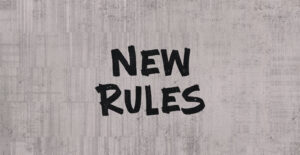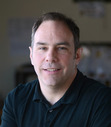Matthew Dicks's Blog, page 38
November 8, 2024
I found the helpers
Wednesday was a difficult day for me. Difficult for many people, I suspect.
I only slept two or three hours before rising around 3:30, having given up on sleep.
I always knew that Trump could win the election, but I did not see the size of his victory as a possible outcome.
A twice-impeached felon and self-described serial sexual assault perpetrator who was found liable by a jury of his peers of sexual assault and who also attempted to subvert democracy and stood by with glee while the US Capitol was attacked has somehow convinced half the voters of this nation that he is worthy of the highest office in the land.
It’s unthinkable.
Of course, the fact he stole money from charities, stole money from Americans via a fake university, and bragged about sneaking into the dressing rooms of the Miss Universe contest to stare at young, naked women didn’t stop people from electing him before, so perhaps I was being shortsighted and naive.
I did not recognize the level of racism, misogyny, xenophobia, greed, misinformation, and tribalism in our country.
I was so profoundly disappointed in my fellow Americans and angry with them for placing so many people in jeopardy by electing this lying, ignorant narcissist again.
So, Wednesday was tough.
But once the sun had risen, I went to work and taught a diverse group of glorious, curious, occasionally obnoxious children to read, write, and solve math problems. I helped them navigate friendships and conflict. I tried like hell to make them laugh and love school. I attempted to be a role model for their future endeavors.
It was a perfect way to spend the day.
Then, Elysha and I went to Clara’s parent-teacher conferences, where we met with a team of dedicated professionals who support our daughter on a daily basis and are helping her thrive beyond our wildest dreams.
We listened as they discussed her academic success, her grit and perseverance, her growing independence, and much more. There was talk of honors classes, AP classes, and college visits.
Heady stuff.
Clara’s teachers and counselors know Clara, adore her, and are deeply invested in her present and future. They are consummate professionals, but even better, they are caring, dedicated, brilliant human beings championing Clara’s dreams and aspirations.
It was a glorious way to end an impossibly difficult day.
Fred Rogers once said, “When I was a boy and I would see scary things in the news, my mother would say to me, “Look for the helpers. You will always find people who are helping.”
I witnessed those helpers on Wednesday night, and they gave me hope.
The people teaching my daughter are the very best of us. They work incredibly hard in often impossible situations for never enough money to brighten our children’s lives.
On Wednesday night, instead of listening to hate, vengeance, selfishness, and stupidity, I found the helpers.
I spent time with the very best people.
This is what I will continue to do:
Look for the helpers, and whenever possible, be a helper myself.
Remind myself of the multitude of kind, intelligent, selfless Americans around me every day.

November 7, 2024
Embrace optimism
In 1973, a man wrote to E.B. White, lamenting that he had lost faith in humanity.
The author was not only a masterful letter writer but also a professional celebrator of the human condition and an unflinching proponent of the writer’s duty to uplift people, so he took it upon himself to boost the man’s sunken heart with a short but infinitely beautiful reply.
It feels right for today:
_________________________________
Dear Mr. Nadeau:
As long as there is one upright man, as long as there is one compassionate woman, the contagion may spread and the scene is not desolate. Hope is the thing that is left to us in a bad time. I shall get up Sunday morning and wind the clock, as a contribution to order and steadfastness.
Sailors have an expression about the weather: they say, the weather is a great bluffer. I guess the same is true of our human society — things can look dark, then a break shows in the clouds, and all is changed, sometimes rather suddenly. It is quite obvious that the human race has made a queer mess of life on this planet. But as a people we probably harbor seeds of goodness that have lain for a long time waiting to sprout when the conditions are right. Man’s curiosity, his relentlessness, his inventiveness, his ingenuity have led him into deep trouble. We can only hope that these same traits will enable him to claw his way out.
Hang on to your hat. Hang on to your hope. And wind the clock, for tomorrow is another day.
Sincerely,
E. B. White
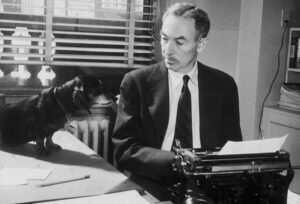
November 6, 2024
The little things. Today, especially.
Back in the spring of 2017, Elysha decided we needed cats.
“I need to pet a cat,” she declared.
Given the political climate at the time, I understood her need and grudgingly agreed. I didn’t want another pet because the heartache of losing our dog, Kaleigh, and our two cats, Jack and Owen, was too hard for me to bear.
But I could see that Elysha needed this, and I love her, so I consented.
Elysha went online and immediately fell in love with two cats — brothers — needing adoption.
Then she discovered that the cats were in Egypt, bound for Connecticut through a program that rescues cats from the streets of Cairo and brings them to loving homes in the United States.
Mind you:
The Connecticut Humane Society happens to be located in our town, but instead of driving up the street to adopt a couple of cats, we waited for them to arrive via an international, overseas flight.
A couple of weeks later, Elysha took possession of the cats in the dark of night behind a Denny’s restaurant in Southington.
Just the way you want to adopt a pet.
I wasn’t nearly as excited about getting the cats when Elysha declared her need for them, but boy, was she right.
Tobi and Pluto have brought immeasurable joy, laughter, and love into our lives. They have become beloved family members and sources of comfort and happiness every single day. I can’t imagine my life without them, and we are all better, happier, healthier people because of their presence in our lives.
I will forever be grateful to Elysha for finding them and bringing them into our home.
Sometimes, when the world feels upside down and things make no sense, the very best thing you can do is focus on the things that bring you joy.
Sometimes, when a minority of Americans in geographically relevant locations make horrendous decisions based upon racism, sexism, xenophobia, misinformation, a lack of information, and fear, it can help to remind yourself of all that is good in your life and how lucky you are in so many ways.
Today, this morning, for me, it’s our cats — Tobi and Pluto — and my wife, Elysha, whose wisdom brought them to us, and the blessed, unforgettable memories of their arrival and first few months with us more than seven years ago.
I’m so happy Tobi and Pluto are with us today, bringing us joy, love, and comfort when we need it most again.
In the words of my wise and beautiful wife, I shall pet a cat today, and it will undoubtedly make me feel better.



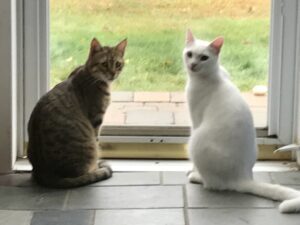








November 5, 2024
Ideal keyboard design for the inefficient typist
Since I spend a good portion of my day on a keyboard, its design is important, especially the specific placement of the keys. I have five laptops in my home right now — four older laptops that serve as backups in case of emergency (and I once went three deep into my backups during an especially unlucky week) — and the one I’m writing this on now.
All of these machines have served me well and have offered me a variety of excellent features, but for me, the most essential feature of all on any laptop is the placement of specific keys on the keyboard:
Arrow Up, Arrow Down, Return, Shift, and most especially, Delete.
The keyboard on my current machine is my favorite by far. The Delete key is located in the top right corner and is easy to find and strike. It’s larger than the surrounding keys, making mis-strikes less likely.
All the other essential keys are stacked along the right-hand side of the keyboard, making them just as easy to find.
I’m lefthanded, which makes this right-side preference a little annoying, but as a lefty, I’ve learned to live in a right-handed world where door knobs, automobiles, zippers, scissors, buttons, notebooks, and so much more are optimized for right-handed people.
Left-handed people are often fairly adept at the use of their right hand because of the totalitarian state of right-handed oppression that we must ensure daily.
So even though I’d prefer those critical keys be moved to the left-handed side of the keyboard, I’ve learned to adapt and make due.
My keyboard is also backlit. This is a great feature for a person who types with four to six fingers at a time and is often forced to look at the keyboard while doing so.
All of this optimization is good because the keyboard—the tool so many people spend most of their day using—is designed to be deliberately inefficient.
In the nineteenth century, when the original keyboards were being designed, fast typing would jam typewriters, so the keyboard layout was designed to purposely reduce a typist’s speed. This is why the “A” key, for example, was placed on the far left of the keyboard. If the keyboard were designed for speed, more frequently used keys would be centered in the middle of the keyboard, but a quick look at the keyboard shows you that this is not the case.
This is exceptionally frustrating for those of us in the twenty-first century who have keyboards that can now keep up with the fastest typists yet have no way of improving their design.
The purposefully inefficient Qwerty keyboard design seems doomed to remain with us forever, which is crazy.
Imagine if the tool you used most often at work was designed to slow you down.
A hammer that misses the nail every fourth time.
A thermometer requires you to take a patient’s temperature five times and average the totals.
A computer program that inexplicably shuts down once an hour.
Actually, some of us may still suffer from this latter problem from time to time.
But despite its poor design, my biggest complaint about the keyboard is the Caps Lock key, which has always been one of the most oversized keys.
Why?
Since the Cap Lock key locks the keyboard into place, why must it be so large? If you’re capitalizing off and on, the Shift key works well and is appropriately sized. But if you want everything to be in capitals — perhaps you’re writing like a fifth grader, an irate uncle, or Donald Trump — the Caps Lock key should remain activated for a while.
So why so damn large?
For those who do not always look up when typing, this can be especially frustrating when you finally peek at the screen and see that the last 400 words have been typed in capital letters.
From what I understand, Caps Lock is important to programmers, database managers, medical staff, and other work-specific tasks. But do we need to keep this extra-large button—the only one that alters almost every other key on the keyboard—alongside the second most frequently used letter in the alphabet?
Are people really switching Caps Lock off and on with a rapidity that requires the key to be so prominently placed on the keyboard and with such great size?
I suspect that keyboard design might not be so important to me if I knew how to type properly, but I missed out on that chance in high school when I chose to take World Geography over Typing 1.
My high school didn’t require students to take typing, and no one told me that I’d one day spend every day of my life writing books, blog posts, magazine columns, plays, poems, emails, letters, and more.
In my junior year, when a teacher required a research paper to be typed, I rebelled. Since I hadn’t learned the skill and hadn’t been required by the school to learn it, how could I be required to type?
Also, since I had never taken a typing class, I wasn’t permitted to use the school’s typewriters, so I didn’t even have access to the equipment needed to complete the assignment.
So I refused.
I wrote the paper by hand and handed it to the teacher, daring her to reject it. I also penned a front-page opinion piece in our school newspaper titled “The Right to Write,” arguing that my high school was making it impossible for me to be a successful student.
More than three decades later, I still have copies of the newspaper. It was one of the first things I’d ever written that I thought was good, and re-reading it today, more than 35 years later, it sounds like me. A little clunky at times, but a good bit of argument.
Of course, I ensured that the article was published one day before I submitted my handwritten assignment, which put that teacher in a bit of a pickle.
That article resulted in a contentious meeting with the vice principal, Stephen Chrabaszcz, and an ultimate change in school policy:
Students who had not taken a typing class would no longer be required to type assignments.
It also resulted in a requirement for freshmen to enroll in a typing class in subsequent years.
It was the first — but certainly not the last — time something I had written outraged teachers, angered school administrators, forced me into contentious and combative meetings with administration, and sometimes effected a permanent policy change.
More than three decades later, I’m still doing that, too.
I just did it a couple of weeks ago.
Some things never change.

November 4, 2024
We forget the terrors of the past
In 1976, three armed men kidnapped 26 California children and their school bus driver. They brought them to the desert and ordered them into what looked like a massive grave — a moving van buried six feet underground.
One by one, the children climbed down a ladder and into the van. After the last student entered, the kidnappers removed the ladder and buried the vehicle under several feet of dirt.The bus driver eventually devised a plan for escape while the kidnappers slept.All survived.______________________Between 1968 and 1972, more than 130 American airplanes were hijacked.Sometimes, there was more than one hijacking on the same day.Radical groups in the Middle East had turned to hijackings as a means of seizing the spotlight. They would commandeer these flights to land in places like Cuba and Central America.______________________Unknown to humans, the ozone layer, which protects the Earth and every living thing from the sun’s harmful radiation, began thinning in the 1970s thanks to the use of chlorofluorocarbons, which break down ozone molecules in the upper atmosphere.Without the ozone layer, harmful UVB radiation would reach the Earth’s surface. This increased exposure to ultraviolet radiation can cause skin cancer and eye cataracts. It can also severely damage crops, plants, and microorganisms, affecting entire ecosystems and food chains.The hole in the ozone layer was first discovered in May of 1985. In 1987, the Montreal Protocol ended the use of chlorofluorocarbons. Though the hole over Antarctica remains today, it is steadily improving.I mention this because I think we sometimes forget the terrors of the past and assume that today’s world is the worst it’s ever been.Our memories are short, and our penchant for placing ourselves in the center of every narrative is strong.People have struggled before. They will struggle again.We should probably stop thinking our storm is always the biggest storm of all.
November 3, 2024
Disastrous beginning. Otherwise brilliant.
A friend recommended this talk to me, which is admittedly in my wheelhouse because it deals with two things I know well:
McDonald’s and existential dread.
It’s an excellent talk—complete with suspense, humor, and surprise. It’s beat-by-beat storytelling at its best, told by someone genuinely enthusiastic about the subject. The use of visuals is outstanding, and the misdirection deployed is impressive. It’s a mystery of sorts and culminates in a moment that I will remember for a long time.
One problem:
The first four minutes are not good. They are pretty terrible. The first four minutes have nothing to do with the talk. They are essentially used to answer a question that was not asked:
“What have you been doing since we saw you last?”
No one asked, and even if they did, don’t answer that question. The answer is boring, self-congratulatory, and, worst of all, not entertaining.
This is a mistake because beginnings are critical:
They are the opportunity to capture your audience’s attention or lose it forever. It can also effectively frame everything that follows and establish the speaker as someone who can be trusted.
A poorly crafted beginning can ruin otherwise outstanding content.
I would’ve quit on the talk around the one-minute mark had the friend recommending the talk not been so reliable in their recommendations.
I’m glad I stuck through the awfulness to get to the brilliance.
So you have three choices:
Don’t watch the talk. That would be dumb.Watch the entire talk and learn from his four-minute mistake.Advance to the four-minute mark and watch something great absent the catastrophic blunder.November 2, 2024
Grace seems a little ridiculous
Possible hot take — meaning you might not love this idea:
The United Nations estimates that more than 10,000 children die from hunger and related causes every day.
A damn tragedy beyond comprehension.
Knowing this…
Saying grace at mealtime — thanking God for your dinner — and thus implying that God is looking out for your nutritional needs — while thousands of people — including children — are starving and likely dying between bites strikes me as…
Myopic?
Self-centered?
Thoughtless?
Ridiculous?
I’m not suggesting that the act of saying grace does any harm. Children don’t starve because people thank God for their food while others have none, but the logic behind this particular expression of gratitude escapes me.
Crediting God — at least in part — for your meal seemingly acknowledges that God also has a role in the starvation of others around the world.
Right?

November 1, 2024
Resolution update: October 2024
Every month, I report the progress of my yearly goals to monitor progress (or the lack thereof) and hold myself accountable.
The following are the October 2024 results.PERSONAL FITNESS1. Don’t die.
I’ve been battling bronchitis for most of the month. It’s not deadly, but it’s a giant pain in the ass.
Almost defeated.
Still alive.
2. Lose 10 pounds.
I have maintained my gain of four pounds, largely thanks to copious amounts of cough drops.
3. Do a targeted push-up workout at least four times per week.
Despite my illness, I completed this goal by doing the bare minimum each week.
4. Complete 100 sit-ups four times per week.
Despite my illness, I completed this goal by doing the bare minimum each week.
5. Complete three one-minute planks four times a week.
Done.
6. Cycle for at least five days every week.
Done. Thanks to travel and illness, I only rode the bike for 21 days in October, but that meets the goal.
I’ve recorded 289 rides in 305 days in 2024.
7. Meet or beat the USGA’s average golfing handicap for men of 14.2.
My current handicap is 25.2, down from 25.5 last month. Still a high number but improving.
But I’ve come to realize something important via research:
The average male golfer’s handicap isn’t 14.2 because most golfers don’t maintain a handicap and those who do tend to be a minority of better, more serious golfers who are active members at country clubs.
I’ve set a goal that may be unrealistic.
WRITING CAREER8. Complete my eighth novel.
I continue to work on the book based on the editor’s feedback. I am making excellent progress. It was supposed to be done at the end of August, but I am not quite finished.
Very close, though.
9. Write my next Storyworthy book.
My next book will not be a storytelling book. My agent and I have decided upon a novel instead.
That said, I have another storytelling book written in first-draft form, and I’m wrapping it up. It won’t go to the publisher soon, but it’s done.
10. Write, edit, and revise my golf memoir.
Work has begun on adding to and revising. As golf season ends in a month — or two or three — this book will keep me company through the winter months.
11. Write my “Advice for Kids” book.
Excellent progress made. A rough draft should be complete by the end of the year.
2. Write/complete at least three new picture books, including one with a female, non-white protagonist.
I’m writing children’s books about Connecticut’s infamous October 2011 snowstorm, the gypsy moth invasion of New England in 1981, and the lullaby “Rock a By Baby.”
The rough drafts of all are complete. I’ve read one of them to my class for feedback. I’ll finalize them in the final months of 2024.
I have three other ideas I’m beginning to work on, too.
13. Write about my childhood in partnership with my sister, Kelli, at least twice per month.
Kelli and I spent a day together in February but forgot to discuss this topic. Eight months later, we still need to discuss it.
14. Launch a Substack.
Substack is forthcoming, I think. I’m still unsure if I want to put anything I write behind a paywall.
But I’m discussing monetizing with experts, and I’m enrolled in a course on managing Substacks effectively.
15. Write a new solo show.
All the work on this project is done in my head since I’ve never written down anything I say onstage, so I don’t have much to show for my efforts, but I am working hard nonetheless.
I’ve accumulated all of the stories I plan to tell as a part of the show, and I have them ordered properly. I’m now crafting transitions and considering other elements in the show.
16. Write a musical.
No progress.
17. Submit at least three Op-Ed pieces to The New York Times for consideration.
Done!
Three so far in 2024. All rejected.
I also submitted all three to the Washington Post. Also rejected.
18. Write at least four letters to my father.
One letter was written in October.
Two letters written in 2024 so far.
19. Write 150 letters.
Done!
I wrote 24 letters in October. The recipients included people who assisted in my Eagle Scout project, students, and friends.
I’ve written a total of 176 letters in 2024.
20. Write to at least six authors about a book I love.
No letters were written in October.
I’ve written letters to authors Andrew Wilkinson and Joe Rocco so far.
I have a list of five authors to write to before the end of the year.
STORYTELLING/SPEAKING CAREER
21. Perform a new solo show.
Initially, I planned on performing at TheaterWorks in Hartford in November, but complications with their scheduling have pushed that back to April 2025.
22. Complete the re-recording of Storyworthy For Business.
Recording complete! I need to do some voice-over, and then I’m done!
23. Record and produce at least two new Storyworthy courses.
I produced and sold another webinar in October, bringing the total to four in 2024.
We’ll also carve up the new Storyworthy for Business course into smaller, separate courses, extending this goal considerably.
24. Produce a total of six Speak Up storytelling events in 2024.
Done!
My “Stories Sell” book launch event — complete with lots of stories and special guests — took place on October 5.
Six shows have been produced so far in 2024. They include:
“Matt and Jeni Are Unprepared” on March 2 at TheaterWorks in Hartford.“Sportsing” on March 16 at the Connecticut Museum of Culture and History“School” on May 3 at Sedgwick Middle School in West Hartford, CTSpeak Up – CPA Prison Arts show on June 5 at The Pond House in West Hartford, CTGreat Hartford Story Slam on July 27 at Hartford Flavor Company“Stories Sell” book on October 5 at the Connecticut Museum of Culture and HistoryWe also have the following show scheduled for 2024:
November 8: “Matt and Jeni Are Unprepared” at the Playhouse on Park in West Hartford, CTYou should come! Tickets here.
25. Submit pitches to at least three upcoming TEDx events, hoping to be accepted by one.
No progress.
I spoke at TEDxBU on April 20. It went very well, and the recording should be online soon.
26. Attend at least eight Moth events with the intention of telling a story.
Done! I attended one Moth StorySLAM in October in NYC.
My name was not pulled from the hat.
A total of 13 Moth events so far in 2024.
27. Win at least one Moth StorySLAM.
Done. I won:
Boston StorySLAM on June 25Boston StorySLAM on February 27NYC StorySLAM on July 17I’ve won three of five StorySLAMs where I’ve told a story so far this year.
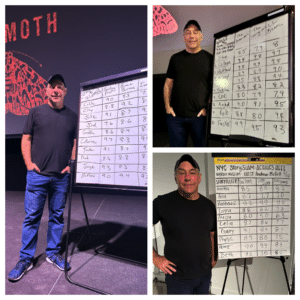
28. Win a Moth GrandSLAM.
I competed in the Moth GrandSLAM in Boston in March and placed second.
I should’ve won, but I think that a lot.
29. Pitch “You’re a Monster, Matthew Dicks” to at least a dozen theaters and/or directors in 2024.
I’ve pitched “You’re a Monster, Matthew Dicks” to two theaters so far in 2024.
I performed the show on March 30 at the Mopco Improv Theater in Schenectady, New York.
30. Produce at least 24 episodes of our podcast Speak Up Storytelling.
No progress.
31. Perform stand-up at least six times.
I’ve performed stand-up twice in 2024 — both shows in Ottowa, Canada.
I have a stand-up open mic planned for December, but this will only get me halfway to the goal.
32. Pitch three stories to This American Life.
One story has been pitched thus far.
33. Submit at least three pitches to Marc Maron’s WTF podcast.
No progress.
34. Send a newsletter to readers at least 50 times.
Done!
At least seven newsletters were written in October, bringing the total in 2024 to 51.
HOME35. Organize the basement.
Progress continues but has slowed.
Since school began, Elysha has been less speedy about sorting through bins with me.
The goal:
Organize all bins in the basement in a logical, identifiable orderEliminate anything no longer wantedStore Elysha’s classroom materials in an organized manner36. Clear the garage of unwanted items.
Elysha’s long-forgotten classroom detritus is the last pile to be eliminated. She has begun bringing the bins to school, and this project is nearly complete.
Two bins to go.
FAMILY/FRIENDS37. Text or call my brother or sister once per month.
Done.
38. Take at least one photo of my children every day.
Done.
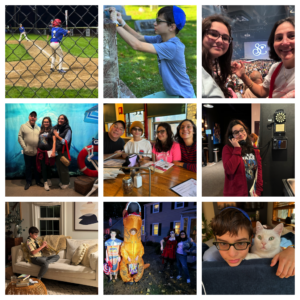
39. Take at least one photo with Elysha and me each week.
Done!

40. Plan a reunion of the Heavy Metal Playhouse.
No progress.
41. I will not comment positively or negatively about the physical appearance of any person save my wife and children to reduce the focus on physical appearance in our culture overall.
Done.
42. Surprise Elysha at least 12 times.
Done!
Four surprises in October:
I sent flowers to Elysha and her class just because.I located and surprised Elysha with a 100-Grand bar — one of her three favorite candy bars.Tickets to “The Shark Is Broken” at the Playhouse on ParkTickets to “Jekyll and Hyde” at The Hartford StageA total of 14 surprises in 2024 so far:
Tickets to “Little Shop of Horrors” on BroadwayTickets to “Merrily We Go Along” on BroadwayTickets to “Tommy” on BroadwayCheesecake delivered to Elysha and her teammates during an especially challenging dayA surprise weekend spent in Rhode Island with friendsTickets to “The Outsiders ” on Broadway this monthA well-timed sweet teaA basket full of things Elysha lovesDinner on the tableFirst-class tickets to San FransiscoI sent flowers to Elysha and her class just because.I located and surprised Elysha with a 100-Grand bar — one of her three favorite candy bars.Tickets to “The Shark Is Broken” at the Playhouse on ParkTickets to “Jekyll and Hyde” at The Hartford Stage43. Play poker at least six times.
Done!
I’ve decided to count poker games with Charlie since they are serious affairs with candy at stake.
A total of seven games in 2024.
I’ve also scheduled a game with friends for October but failed to get enough players to make it happen.
I need better friends.
44. Spend at least six days with my best friend of more than 30 years.
Done!
We spent one day together in October —eight so far.
MUSIC45. Memorize the lyrics to at least five favorite songs.
No progress in October. I need to find a song I want to know.
Memorized so far:
“Our Wonderful Lives” by Styx
“Come a Little Bit Closer” by Jay and the Young Americans
“Fox on the Run” by Sweet
46. Practice the flute at least four times per week.
I did not practice in October. I’ll blame it on bronchitis.
MISCELLANEOUS PROJECTS
47. Read at least 12 books.
I read two books in October, bringing my total to 24 in 2024.
“Of Mice and Men” by John Steinbeck
”Mediations” by Marcus Aurelius
Though I’ve finished “Meditations,” I will continue to read it, probably for the rest of my life.
I suggest you should, too.
I’m currently reading:
”Outlive” by Peter Attia and Bill Gifford
“The Power Broker” by Robert Caro
“Excellent Advice for Living” by Kevin Kelly
”Miracle and Wonder” by Bruce Headlam and Malcolm Gladwell
Books read in 2024 include:
“Upstream” by Chip Heath”Happy Pepple Are Annoying” by Josh Peck”Comedy Comedy Comedy Drama” by Bob Odenkirk“The Power of Regret” by Daniel Pink“Fluke” by Brian Klass“Misfit” by Gary Gulman“How to Weep in Public” by Jacqueline Novak“The Anxious Generation” by Jonathan Haidt“The Demon of Unrest” by Erik Larson”You Like It Darker” by Stephen King”A Short Guide to a Happy Life” by Anna Quindlen”How to Say Goodbye” by Wendy McNaughton”We’re All In This Together” by Tom Papa”Smart Brevity” by Jim VandeHei, Mike Allen, and Roy Schwartz”Hello Molly” by Molly Shannon“The Deerfield Massacre” by John Swanson”Duma Key” by Stephen King”Never Enough” by Andrew Wilkinson“Opposable Thumbs” by Matt Signer“The Splendid and the Vile” by Erik Larson”One the Edge” by Nate Silver“Green Lights” by Matthew McConaugheyMediations” by Marcus Aurelius“Of Mice and Men” by John Steinbeck”
48. Finish reading TIME’s 100 Best Children’s Books of All Time.
I did not read any of these books in October. I read plenty of picture books to my students, but no new ones from the list.
I may need to find or purchase some of the books on the list that are not in my school’s library. I also need to get my students to start hunting down these books in the school library.
I’ve read 36 books from the list thus far.
49. Unify my passwords using a password manager.
Done!
50. Learn to use QuickBooks for my business.
Done! Invoicing, payroll, and taxes are now all managed via QuickBooks. It’s much easier than I thought.
51. Rectify the heating problem in my studio.
I received estimates on this project, which is more than expected.
As a temporary measure, I purchased an electric radiator and plugged it into a Bluetooth outlet to turn the heat on before going downstairs, allowing the room to be warm when I entered.
This solution might be better than the thousands of dollars required to install heat, and it might be my permanent solution, depending on the possibility of finishing other parts of the basement.
My friend Chris may have an idea, too, so I’m holding off on declaring this complete.
52. Learn the names of every employee who works at my school.
In October, I could not find a colleague whose name I did not know. Someone may still be lurking in the building who I cannot identify, but I haven’t found them yet.
53. Assemble a complete toolbox.
Done! Completed as a part of the basement cleanup.
54. Edit our wedding footage into a movie of the day.
No progress. I’m actually looking forward to this job, but it will require me to learn how to edit videos using a new program.
Thankfully, I employ someone who knows exactly how to do this.
55. Memorize three new poems.
I memorized James Joyce’s “Tree” and Robert Frost’s “The Road Not Taken.”
I’m still working on Act V Scene 5, lines 18-28 of Macbeth.
56. Complete my Eagle Scout project.
Done!
Completed on October 12. A total of 42 volunteers plus my family joined me on a perfect day to complete this long-awaited project.
I’m hoping that completing the project eventually makes me feel better, as I had originally hoped.
57. Post my progress regarding these resolutions on this blog and social media on the first day of every month.
Done.
October 31, 2024
A big, happy, forgotten party
On April 14, 1971, my great-grandparents celebrated their 50th wedding jubilee.
I learned this thanks to the newspaper. Someone sent me the article from The Call — the paper of record at the time —detailing the event, which I apparently attended at the ripe old age of two months.
It was quite the affair, with friends and relatives attending from as far away as Connecticut and Montreal.
I wish I could go back in time and witness the occasion and see my parents, grandparents, aunts, and uncles in that moment of joyous celebration.
Though the amount of second-hand smoke filling the room was probably unfathomable.
I grew up next door to my grandparents, and my great-grandfather lived with my grandfather — his son — until his death.
I remember Great Grandpa well. I have no recollection of my great grandmother, so she must’ve passed away sometimes after this party and before I became conscious of my surroundings. Great Grandpa remained permanently perched in a large chair in front of a table piled with papers, books, and magazines.
I’m sure he left the chair from time to time, but I have no memory of it.
I remember him as a sweet old man who was always willing to talk and loved to ask me questions.
I was thrilled when a friend sent me this newspaper article — featured on a historical Facebook page for my hometown of Blackstone, MA. Absent this newspaper clipping, I wonder if anyone remembers the party anymore. My father and his surviving brother and sister were likely in attendance, but do they recall a party that happened 53 years ago?
Therein lies the tenuous nature of life. Enormous effort and planning went into a glorious celebration that soon became irrelevant and forgotten.
I hate that.
I hate it so very much.
I’m happy my great-grandparents enjoyed what sounds like a splendid day of celebration.
I’m pleased to know I was in attendance, though I was less than 60 days old.
But I’m pained by how quickly it has faded into the past. How certainly it will someday be forgotten forever.
I yearn for more permanence in this world.
It’s probably why I tell so many stories.
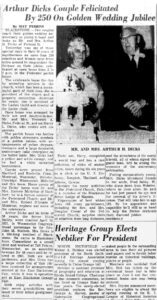
October 30, 2024
Matt’s Rules of the World
If I were ruler of the world, I would immediately enact the following laws to improve the quality of life for all of humankind:
1. Drivers who pull their cars alongside each other in the middle of the road and roll down their windows to chat (thus blocking the road for sane people) shall have their licenses revoked for a period of no less than six months.
2. If a public building has two or more exterior doors, all such doors shall be unlocked and accessible at all times. If a patron walks into a door expecting it to open and finds it locked, the business in question shall pay the patron a fee of $50,000. If said patron bashes their head on the door in the process (a feat I have accomplished several times), ownership of the business shall immediately be transferred to the bloody-nosed patron.
Why install double doors if one of them is always locked?
3. Anyone wearing clothing containing a brand name or any other assemblage of words on the seat of their pants shall be required to remain seated for the rest of their natural life.
Side note:
If I really had my way of all things, I would remove brand names from all clothing items and accessories since the inclusion of these brand names is merely an indicator of the approximate cost of the item and serves no useful purpose other than to advertise for the clothing company while making people who require such monetary validation momentarily happy about their otherwise vacuous souls.
5. It is hereby forbidden to congratulate a friend on purchasing a vehicle if that friend is over twenty-one. When the purchase of an automobile becomes congratulatory-worthy, priorities must be re-examined immediately.
6. When going to the gym, one must drive to an open parking spot and park their car immediately. No more occupying the middle of the aisle, directional flashing, waiting for a spot closest to the door to open up. It’s the gym. Walk a little bit. Get some pre-exercise exercise.
9. Selfie sticks should be immediately banned. It’s bad enough that future archaeologists may judge our society based on things like The Bachelor, Antonin Scalia, and hipsters who wear slouchy winter hats in the summer. We cannot allow the selfie stick to also define us.
10. Movie theaters must be equipped with cellular jamming technology, effectively disabling the phones of every person within the theater at the film’s onset.
11. People who pay by check at the grocery store — thus slowing down the line considerably — must take a mandatory class on the safe and effective use of debit and credit cards before being allowed to eat any of their purchased groceries.
